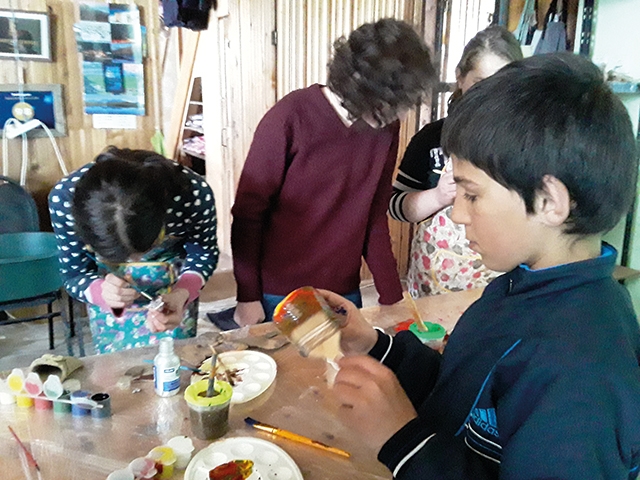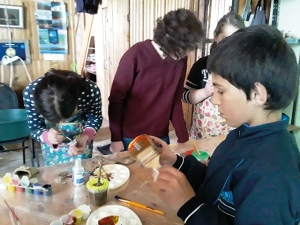Sleeves Still Up: Etseri, Svaneti
Blog
After five mostly successful firings, the 2nd week of the clay workshop has been focusing on decorating the pieces, mostly with gouache and spray-on varnish. A few of them exploded in the Svan-stove-kiln, likely due to hidden air pockets; but overall there was about a 96% success rate. Not bad, considering the quick buildup to full temperature and lack of insulated ceramic shelves which are necessary features of this kiln and firing. The fittest pieces survived. The future daughter in law of the teacher made and presented me an adorable caricature monster of myself, complete with CYMRU toque, glasses and blue slippers.
Here, too, with gentle music in the background, there was a really good creative atmosphere. Teacher and children alike were delighted to see their work come out of the kiln, and ready to paint it. We couldn’t use actual ceramic glazes because a) They aren’t readily available in Georgia’s mostly unglazed clay culture and b) I have no facilities for firing potentially messy glazed works, which might drip and leave residue on what is mostly an oven for food preparation!
The learning curve for what will make it intact through a firing and what won’t is a bit difficult when you only have a few days per year to work and learn from your mistakes, but this is the current situation, and a whole lot better than no ceramics lessons and workshops at all.
The whole spectrum of colors is available to the children, as well as gold and silver, and brushes of all sizes, and even texturizing items like sponges and patterned surfaces. Nothing to limit the active imaginations of these children who are thrilled to be able to spread some paint around, get a bit spotted with it, and actually make and decorate something permanent of which they can genuinely be proud. Some parents have dropped in as well, not doubt hearing the rumors of strange bohemian goings-on in the Hanmer household, and been impressed with that their youngsters are creating.
A local school bus driver for Etseri’s furthest away hamlet, Hebuti, some 7 km away, volunteered the information that clay has been mined above his place, and offered to bring us a sample. Great, we responded, expecting something in spring when snow would be gone, and the very next day he appeared with a bag of it! A bobcat had been digging in the area, despite the winter season, so some had been exposed and he grabbed some. It seems to be pretty good, although it will need a thorough process of washing and fine-mesh sieving to purify it of sand, stones and other debris, and then make, dry and fire a test object. This will show us its necessary firing temperature range, plasticity, and other characteristics, and tell us whether to call it an earthenware (low temperature: lighter and more porous) or, best, a stoneware (high temperature: stronger and denser).
To be able to have some hand in reinvigorating a purely local source for mining clay, as well as more of an interest in using it to make totally local pottery and hand-built pieces or sculptures, would be a great privilege. Such are the thoughts which arise when one dips a toe into the waters of creativity in an area which is… still rather too apathetic, needing some kind of stimulus to get it further and more so on its own feet. May one dream long-term of an industry to rival that of Shrosha, in the dividing pass between east and west Georgia, and another reason for local young people to stick around and make a living and a life? Such are indeed my dreams for this place.
Tony Hanmer has lived in Georgia since 1999, in Svaneti since 2007, and been a weekly writer and photographer for GT since early 2011. He runs the “Svaneti Renaissance” Facebook group, now with nearly 2000 members, at www.facebook.com/groups/SvanetiRenaissance/
He and his wife also run their own guest house in Etseri: www.facebook.com/hanmer.house.svaneti
By Tony Hanmer












